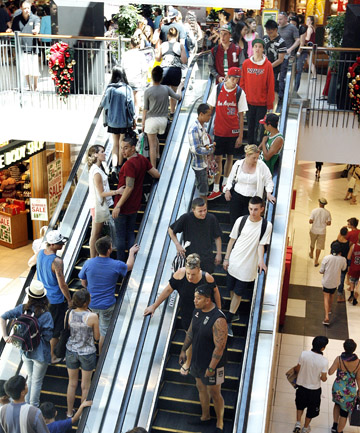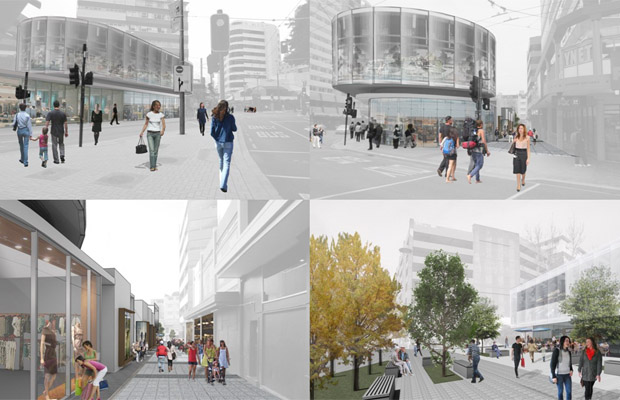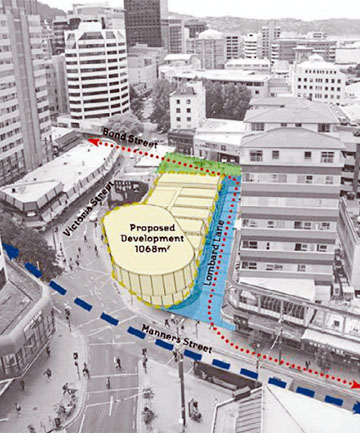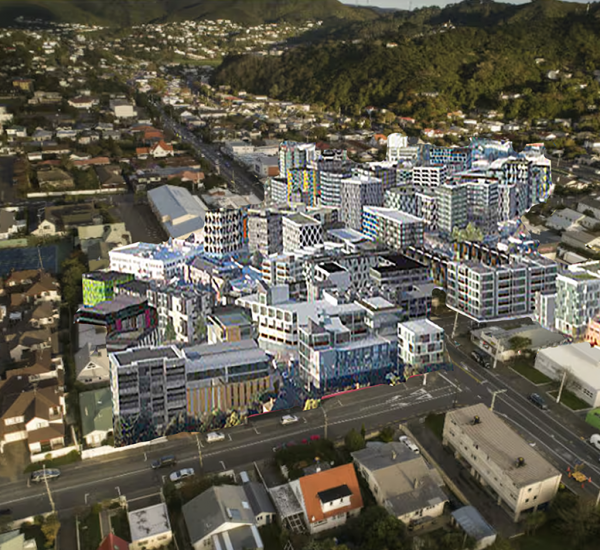On May 21 there was an article in the DomPost by Hank Schouten about shopping malls. The article said (provocatively, I thought), that : “More malls needed, say researchers”. This research, based on info paid for by international property wranglers Jones Lang LaSalle, noted that New Zealand has “only 0.4 square metres of mall space per person, which is low by international comparison.” Thank God for that, I thought, but then again – I am not their target market. Jones Lang LaSalle director Andrew Brown apparently noted that “Wellington’s 24 enclosed malls compete vigorously with Wellington’s inner-city retail offering, but he believes there is room for more mall space.” He reckons there is room for a further 37,000sqm ie another Westfield Queensgate.

It is fair to say that, online at least, this proposal went down like a bad smell in a crowded lift. People clearly turned up their noses and both Elvis and I left the building. I’d argue that Wellington’s apparent 24 enclosed malls are not competing with the other retail (they are all just at street level really, and I’d venture to say that the shops directly on the street do far better business than the mini-malls do) and should not be divided off – the great thing about Wellington is that it has NO MALLS. It seems that I am not alone in thinking that. Comments about that article online at Stuff included:
“Please not another WESTFIELD!!!!! they are all dull and boring Shopping Centres, same old same old!. Yes maybe more malls BUT please ensure they are different.” from I loveNewZealand.
“Malls are dead – the only reason other places still have them is because they’re there, not because they’re wanted. If you want a spread of big stores and free parking, go to the Airport area or to Porirua; leave Welly’s CBD as a place of interest and character. It’s one of the great joys of living here.” from bella-m
“Queensgate gutted the Hutt Valley and Wainuiomata particularly, and now the Hutt Council want to do it again in Petone. What the region needs vs what the developers want to shove down our throats and destroy the character of the region in the process are two different things – frankly anyone that wants to live in a mall should shift to Auckland and leave Wellington for people who actually like to live in communities, interact with their neighbors and enjoy their environment.” from winzurf
and my own personal favourite:
“To put it simply. I’d rather saw off my own legs with a wood splinter than spend an hour in a mall. They are a grim reminder of how dependant some people have become on spending all the cash they have on things they dont need. I get everything i need from food and stuff. They have food. and stuff.” from RonSwanson – good on you Ron – get busy with that splinter!
Jones Lang LaSalle did however have this interesting set of statistics:
United States has more than 2sqm of mall space per person, but it is oversupplied.
Canada and Australia are seen as mature markets:
Melbourne has 0.88sqm of mall space per person
Sydney has 1.07sqm of mall space per person
New Zealand has 0.4sqm of mall space per person.
Canterbury has 0.64sqm of mall space per person
Auckland has 0.6sqm of mall space per person, “more than anywhere else in the country”, and yet curiously Waikato is also reported as having the most mall space per person in New Zealand, with 1sqm per person. They note that Auckland’s mall patronage / metreage is “significantly lower than we would expect for a growing city of 1.5 million”, and JLL estimates that Auckland will need 357,000sqm of extra mall space, the equivalent of nine Westfield St Lukes malls in the next 18 years. If you want to read further, the original JLL report is here.
Perhaps the best retort to this is a passage written by Elizabeth Farrelly, in her fantastic 2008 book Blubberland – the Dangers of Happiness, where she says:
“The contemporary shopping mall is a classic instance, striving to ape the complexity and interest of a traditional market, but with one, overarching difference; the space is privately owned and entirely under private control. The air is cooled and conditioned and gently muzak-laced; the lighting, level changes, transparency and detail are minutely orchestrated to slow your gait within microsends and lull you into buy-mode; and no one, other than the owner, has any right to be there. Everyone else is there on sufferance. Anyone undesirable, or homeless, or obviously poor, can be summarily shuffled out so that the mass-narcosis of consumerism never pops.”(p138).
It seems to me that today’s article on a proposed Mall just off Manners Mall is a response to that, yet it also has commenters to the Stuff website frothing at the mouth.
“A multimillion-dollar Melbourne-style mall is planned for central Wellington, with a private developer seeking ratepayer backing for the boutique shopping and eating complex. The mall would transform the area around the old post office between Victoria St and Lombard Lane, with room for 10-15 shops and eateries in the 1068-square-metre space. Cook Strait Properties is behind the project, and co-director Luigi Muollo said the aim was to revitalise an area of the city that was currently underused.”
There is nothing too offensive about the proposal, except for this line: “Wellington City councillors will debate today whether to pledge $150,000 of ratepayer money to investigate the project’s development” and that is the bit that has got commenters going on Stuff:
slaine says: “This is ludicrous. No council should even allowed to contemplate spending ratepayer money on any form of retail development.”
shane888 says: “I like the design and location (the area is currently pretty grotty), but I fail to see why ratepayers should help pay for what will be a privately owned complex.”
and that is pretty much the argument in a nutshell. The area is certainly in need of a bit of work, although it is those slightly grotty parts that make a city more interesting. One of Wellington’s finest brothels (apparently) currently resides on the top floor – as well as some of Wellington’s finest graffiti walls. As published, the Jasmax proposal for Muollo is on a tiny wee drawing, and there is nothing on Jasmax’s website as yet. So this is all we have to go on:

and this rather basic diagram:

There’s not enough to really chew over here – good points include the deletion of the awkward pedestrian clashpoint at the door to Barkers (used to be Paris Texas) – and a big curved glass frontage at this point would seem to be a reasonable improvement. What Jasmax and Muollo are trying to do of course is to pull the crowds walking towards Willis St away from their designated route along the congested Manners St, and down a currently back lane. That’s just all good planning, and I don’t think anyone would really try and stop that. Its a small mall, not a Pall Mall, but presumably they would need WCC input in enlarging the small grotty alcoholics / degenerate smokers park that they share with diseased pigeons, and also in building a new pedestrian crossing at the junction with Bond St.
Till we see more, I couldn’t really comment more, and so I’ll just give the last word once more to Ms Farrelly, who puts up a decent argument for and against the mall as a form of architecture:
“So it is interesting to note the increasing interiorisation of shopping as an activity. From the traditional street market where interiors were usually makeshift and temporary, to the modern mall where entire city blocks and precincts are interiorised to give the (usually female) shopper the illusion of being in a vast, sparkling, bejewelled, cathedral-like home. Woman like malls because they’re known, comfortable, clean and safe – from muggers and spitters, from sun, storms and mendicants. Here, at fantasy-home, women will relax, and when they relax, they will spend.
Malls titillate and relax, even while they make you feel needy, inadequate and dreamily disoriented. They’re meant to. It’s like chocolate. If you can be made to feel bad, in a small way, the more you want soothing, and the more you buy. One thing you don’t see much of in a mega-mall, therefore, is social life. Whereas in a high street you might stop for a coffee, in a mall you bump into someone, you say hi and press on. This is because, from the first car-park moment, the place is designed as a disconnect, separating you from your reality and from your higher, warmer self. It’s designed to put you in a bubble – a car-like bubble – of self-gratification.
This is another reason why the mall experience begins and ends at the car park. Grey, fumy and jammed with other irritable, bubble-wrapped humans, the car park is no pleasure-dome. It’s designed to do a kind of good-cop-bad-cop routine with the mall interior, to make you more susceptible to the shopping urge. And because it is important that we come to it through the gates of hell, the mall is the first architectural type in history that has an inside but no outside. The mall has interior design, heavily themed and fantasised, but it has no street presence, no public self, no architecture.”(p150, Blubberland)





>Wellington’s 24 enclosed malls
There is Queensgate. And Porirua. And probably Maidstone Mall, providing someone hasn’t shuttered the doors and windows with plywood to keep vagrants from sleeping in its tatty 1960s interior. But where are the other 21 hiding? Are they counting Coastlands, which doesn’t qualify as being in Wellington in my book? And maybe the food court in the BNZ tower, and the interlinked upstairs shops with Whitcoulls anchoring one end?
DavidP – I don’t think they mean Queensgate etc, although I haven’t read the whole report yet. And yes, I think they do mean places like the BNZ Food Court, but also the smaller ones like the little links through to the Terrace from Lambton Quay. I may be completely wrong, but those are the only “enclosed mall” spaces I can think of. But I can’t even remember any of their names – but there is probably at least ten of them ?
Surely the likes of Duke’s Arcade and The Oaks wouldn’t be included in that?
If you read the actual JLL report, instead of just the DomPost’s summary of it, you will note such statements as:
“There are still some 24 enclosed malls in the region. These malls compete vigorously with Wellington’s inner city retail offering in the Wellington CBD limiting the sustainability of overall retail mall supply. In fact some eight of the 24 retail malls in the Wellington Region are located in the central city indicating that the line between street facing high street shops and retail malls in Wellington is somewhat blurred.”
So, yes, Dukes Arcade probably would be part of that, as it is an enclosed space. The Oaks however have really done away with any interior space some years ago, haven’t they?
Report also notes that:
“Wellington is geographically challenged in terms of providing suitable sites for large malls given the topography of the region and the historic zoning of retail and town centres in Wellington’s outer suburbs.”
Personally, I’d say Wellington is geographically blessed, rather than geographically challenged… but each to their own, I guess.
What I do find most amazing is where the report notes:
“The Hawkes Bay and Otago however have 0.12 sqm and 0.26 sqm of retail space per person respectively. This is significantly below the national average. If the amount of retail mall space for example in the Hawkes Bay / Gisborne catchment were to increase to a level whereby total space equated to just 0.30 sqm per person, the region would be able to accommodate an additional 42,000 sqm.”
If the report writer had bothered to actually go to Hawkes Bay, he may realise that retailing (and the shoppers therein) are on the bones of their arse in that region, and already many shops are empty. Building more malls there will only make it worse.
Malls are loathsome.
The description of this lombard st development baffles me, particularly calling it a “mall”
Is it intended that there shops will open off a central enclosed corridor space?
If so then why do they need to council to do up the Lombard street lane
If they intend to turn Lombard street into something akin to Woodward street, with shops opening off it ( which I would support) then why is this thing being described as a mall,
Also they can’t really expand the park much as there is still a large car parking building nearby that needs reasonable access, and pretty much turns that street into a traffic Jam in the evening rush…..
A bit hard on the Lombard Park, Max. I find it an ideal place to pause from my flanneur’s rounds to nibble on an Artcraft date scone. True, some of the pigeons (like the human users) are a little the worse for wear and have a rather heightened sense of entitlement when it comes to date scones, but I would much rather 10 microparks like this one than two or three Midland-scale ones. Seeing that many public servants scoffing and flirting at the same time can be a little unsettling.
Starkive – you know I’m hard. Yes, ok, on reflection, too hard. Actually, the Lombard Park has some great aspects: it faces north, is sheltered from the south, and so is always warmish; it is relatively quiet, as it is not right on to the traffic; it has 3 seats. On the other hand, the seats are normally occupied by smokers, with their filthy little habit, but there is a useful little red steel thing that you can use for resting your bottle of drink on (even if it stops you sleeping there…). And the pigeons, well, the pigeons are a fact of life in every urban environment it seems. I’m happy for you to share your date scones with them…. just as long as they don’t take a bite out of my Fidel’s blueberry muffin…
What did you think of Liz Farrelly’s writing? I love the way she puts words together – weaves a beautiful picture. Way better than I can.
Greenwelly – i think they mean mall as in lack of cars in street. A stretching of linguistic license perhaps?
Oh No!
Not more malls’ 24 is more than enough for 500K people.
Horrible things that they are – could rip the soul out of a human being.
No more.
No rate payers money to help these philistines suck up our hard earned cash with trashy offerings
Elizabeth Farrelly (FKA Libby Farrelly) is, I believe, a product of Auckland University School of Architecture. And yes she can string ’em together, can’t she?
I agree about mall ennui, but you haven’t lived until you’ve been here:
http://en.wikipedia.org/wiki/Mall_of_America
though chances are you may lose the will to do so once do have…
No doubt this part needs some thinking, and I’ve had the same thoughts before about turning that lane into a pedestrian route, it already is my default pedestrian route now that there’s a good cafe (Lamason) down there. And the park is a pretty good spot to find some sun too. But that still leaves Victoria St as largely an ugly mess through this part of Wellington, and I wonder if there might be a better idea out there that involves moving or changing it somehow rather than leaving it as is.
Also. I’m developing an aversion to anything advertised as “Melbourne-style”. I like Melbourne (although it’s architecture has become a bit too “ooh look I put a coloured box on the side of this building” for me, tho there are some gems in there) but anyway what I mean to say is how about we come up with something Wellington-style.
What about the other interesting news this week? To demolish the town hall and build another empty box convention center, or spend 43 million (crikey) strengthening it.
Erentz – yes, that is the big news of the week i agree – but i’m just running out of time to post again this week…. must do some work now and then… (more than happy if you want to post on that..!)
I totally agree with your other points – if the city was being sensible, there would be some answer involving the crappy building on the other side of the street as well, and some method of getting people across this intersection without being run over by cars or buses…
Wellington had a number of these small “temporary” retail buildings (Oaks, Dukes, this one on Victoria St etc) which were put up in the 80s and it was only intended (i think) that they were there for 10 years or so. That is now 30 years ago. Time for them to be demolished and a better solution built!
Interestingly, the proposed site can build up to 75m high without major modifications.
http://wellington.govt.nz/~/media/your-council/plans-policies-and-bylaws/district-plan/volume03/files/v3map32.pdf
There was a previous proposal to build a Wellington franchise of the Columbard “corporate crash pad”, but that never eventuated.
Whenever I walk from the train station up to Courtenay Place, this corner feels like the last corner before you’ve made it there. When Manners Mall was fully pedestrian you felt like you finally had walking freedom when you rounded that corner from Victoria and entered Manners St. It’s a go between area, it would be cool to have something draw you there and stop like the ice cream place by Taranaki St – a crazy open air market maybe with something going on that people just passing through can enjoy.
Greenwelly and Maximum – discussion about whether a mall needs to be enclosed or not seems a bit academic – there are a couple of examples of unenclosed malls quite nearby – Manners and Cuba. This development would be no different, and really an extension of the former – hopefully with a bit more soul than the current reincarnation though…….
That should be Maximus, of course,….
Flat White – Mall by name is different from Mall by nature… I take your point, but personally I in no way consider that Manners Mall was ever a Mall in the modern sense, and nor is Cuba St a Mall in any way. They were/are pedestrian precincts – and what is the important is (especially in regards to what Libby Farrelly is saying above) they Are Not Private. Why, you can go into Cuba St and set fire to your car in the middle of the street to protest against fractional banking if you so wish…. or take a sledge hammer and bash it against some tarmac… while the Police were called for both of those, that’s very different from the wholesale privatisation of space that a Westfield excels in.
And then of course there is Pall Mall… which is a different kettle of fish altogether, and has no shops. And has a cigarette brand named after it. Which is neither here nor there really…
DeepRed – and thank god too i say! That seemed like a very badly thought through suggestion, which is probably one of the reasons why it failed…
What is probably worth noting, is that in the top picture of a mall (Queensgate in Lower Hutt), there are at least 20 people, all young couples, all about the same age, some holding hands, so clearly going to the Mall is a bonding activity (buying fresh new clothes), a nesting process (buying new crap for your pad), and all in a vibrant young age group with no dependents. Mall life = Breeder life. Not for old Fish like you Max!
I hope they can get rid of the pee smell coming from the Lombard St Parking Building. Actually, maybe they should just get rid of the Lombard St Parking Building.